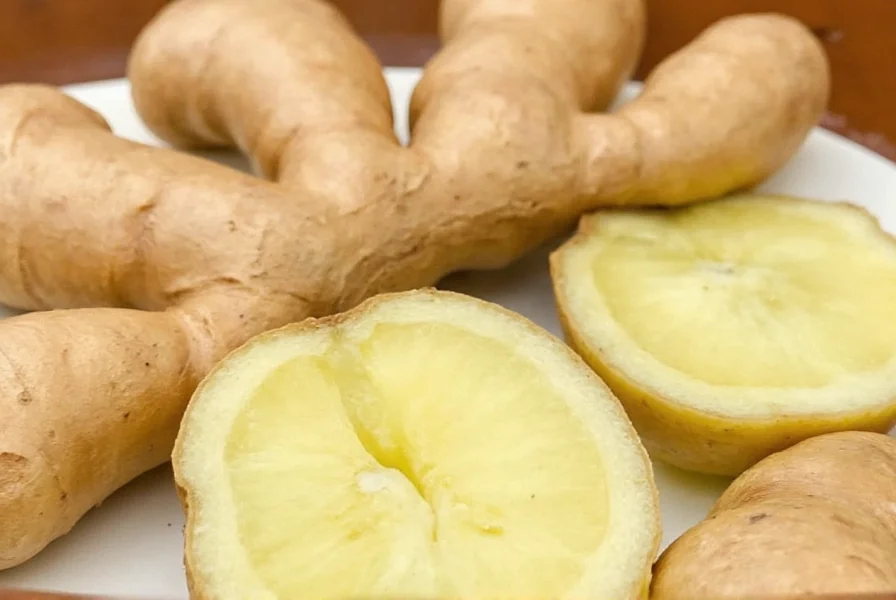No, you don't always need to peel ginger before using it. Whether to peel ginger depends on its age, your recipe requirements, and personal preference. Young ginger has thin, tender skin that's perfectly edible, while older ginger develops tougher, fibrous skin that many prefer to remove. Proper cleaning is essential regardless of peeling choice.
Understanding when to peel ginger can transform your cooking experience while saving valuable preparation time. This comprehensive guide explores the practical considerations for ginger preparation based on decades of culinary expertise and food science research.
Understanding Ginger Varieties and Their Skins
Ginger isn't a one-size-fits-all ingredient. The decision to peel primarily depends on the ginger's maturity and intended use. Fresh ginger comes in two main varieties that determine whether peeling is necessary:
| Ginger Type | Skin Characteristics | Peeling Recommendation | Best Uses |
|---|---|---|---|
| Young Ginger | Thin, smooth, pale yellow skin | Not necessary | Raw applications, pickling, delicate sauces |
| Mature Ginger | Thick, tough, fibrous skin | Recommended | Cooking, baking, strong-flavored dishes |
When Peeling Ginger Is Recommended
Mature ginger, commonly found in grocery stores, develops thicker skin as it ages. This skin becomes increasingly fibrous and can impart a slightly woody texture to dishes. For recipes where texture matters—such as smooth sauces, desserts, or beverages—peeling mature ginger provides a more refined result.
Professional chefs often peel ginger when creating dishes that require a smooth consistency. This includes:
- Infused syrups and simple syrups
- Smooth curries and pureed soups
- Baked goods where texture is critical
- Cocktails and beverages requiring clarity
When You Can Skip the Peeler
Young ginger, sometimes called spring ginger, features remarkably thin skin that's completely edible. This variety appears paler with a more delicate texture. Many specialty markets and farmers' markets carry young ginger during spring months.
You can confidently skip peeling when:
- Using ginger in stir-fries or sautéed dishes
- Preparing pickled ginger
- Creating strongly flavored curries or stews
- Grating ginger directly into recipes
Food scientists confirm that ginger skin contains valuable nutrients and fiber. Leaving the skin intact preserves these beneficial compounds while reducing food waste—a growing concern for environmentally conscious cooks.
Proper Ginger Cleaning Techniques
Whether you peel or not, thorough cleaning is non-negotiable. Ginger grows underground and often carries soil particles in its crevices. Follow these steps for proper preparation:
- Rinse ginger under cool running water
- Use a soft vegetable brush to remove visible dirt
- Scrub crevices gently with the brush tip
- Rinse thoroughly until water runs clear
- Pat dry with clean paper towels
This cleaning process effectively removes surface contaminants without requiring peeling. For organic ginger, this simple cleaning often suffices for most culinary applications.
Alternative Preparation Methods
When peeling seems tedious, consider these efficient alternatives that maintain flavor while minimizing preparation time:
The Spoon Method: Use the edge of a spoon to scrape away skin. This technique follows ginger's natural contours, removing minimal flesh while efficiently separating skin from the rhizome.
Grating Directly: For many recipes, especially those requiring finely minced ginger, grating unpeeled ginger directly into your dish works perfectly. The small skin fragments become undetectable in the final product.

Flavor and Nutritional Considerations
Research indicates minimal flavor difference between peeled and unpeeled ginger in cooked applications. The primary distinction appears in texture rather than taste. However, some traditional culinary experts argue that unpeeled ginger delivers slightly more complex flavor notes in certain preparations.
Nutritionally, ginger skin contains concentrated beneficial compounds including:
- Additional dietary fiber
- Higher concentration of certain antioxidants
- Trace minerals absorbed from the soil
These nutritional benefits support the growing culinary trend toward using the entire ginger rhizome when appropriate.
Practical Tips for Different Cooking Applications
For Baking: Always peel ginger for cakes, cookies, and other delicate baked goods where texture matters. The fibrous skin can create unpleasant mouthfeel in sweet preparations.
For Beverages: When making ginger tea or infused waters, leaving the skin on actually enhances extraction of beneficial compounds. Simply slice thinly and steep as usual.
For Asian Cuisine: Traditional Japanese and Chinese cooking often leaves ginger unpeeled for stir-fries and braises, where the skin's texture complements the dish.

Safety Considerations
Ginger skin isn't toxic, but proper cleaning remains essential. Food safety experts recommend:
- Always washing ginger thoroughly regardless of peeling choice
- Avoiding ginger with mold or significant blemishes
- Storing ginger properly to maintain freshness
- Using clean preparation tools to prevent cross-contamination
Commercially grown ginger may have pesticide residues, making thorough washing particularly important. For conventional ginger, consider peeling if you're concerned about chemical residues, though washing effectively removes most surface contaminants.
Conclusion: Making the Right Choice for Your Recipe
The decision to peel ginger ultimately depends on your specific recipe and personal preference. For most everyday cooking, thorough washing without peeling provides excellent results while preserving nutrients and reducing waste. Reserve peeling for applications where texture refinement matters most.
Mastering this simple preparation technique—knowing when to peel ginger and when to skip this step—demonstrates culinary efficiency without compromising quality. By understanding the characteristics of your ginger and the requirements of your recipe, you can make informed decisions that enhance both your cooking process and final dish.











 浙公网安备
33010002000092号
浙公网安备
33010002000092号 浙B2-20120091-4
浙B2-20120091-4